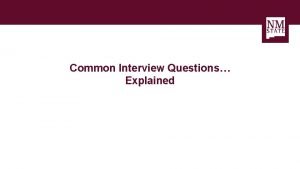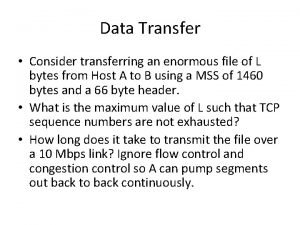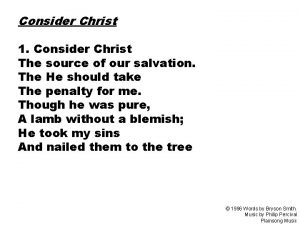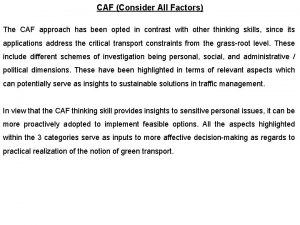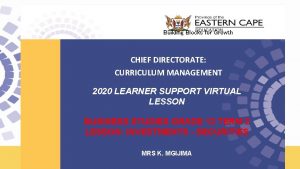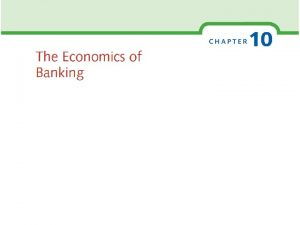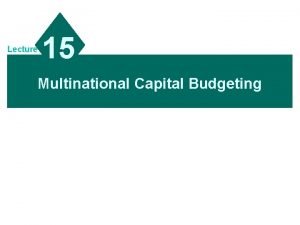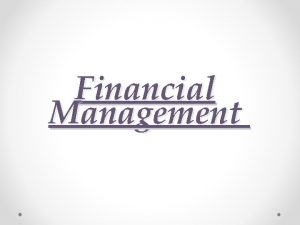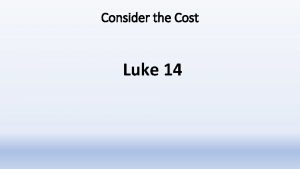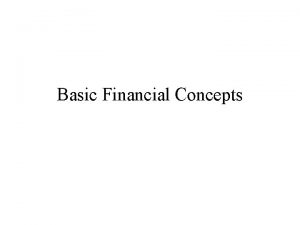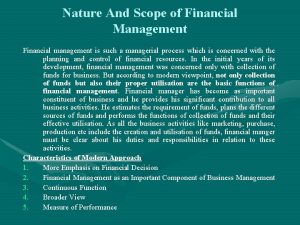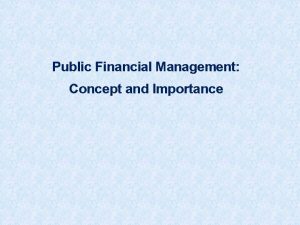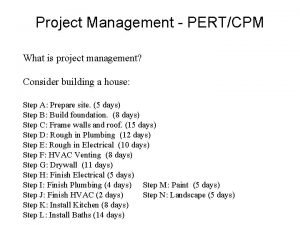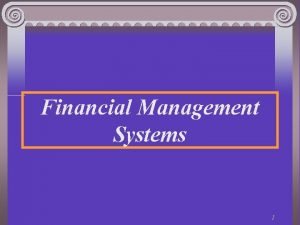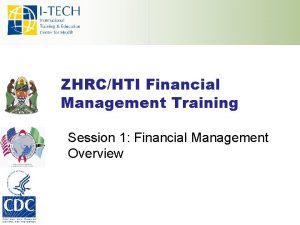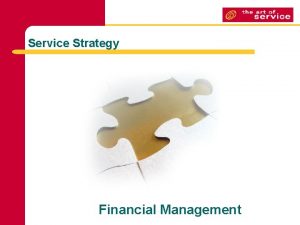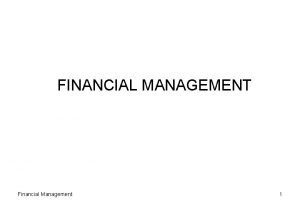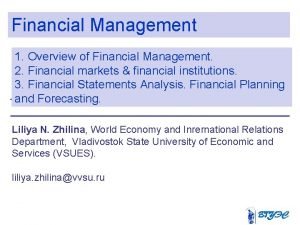Financial Management and YOU Do you consider financial




























- Slides: 28

Financial Management and YOU Do you consider financial management a lone or lonely process? Do financial management and ministry strategies relate? How are our campers and guests, staff, sites and stakeholders affected by our financial management systems or are they? Who in your organization is responsible for financial management? Susan Troutman, Consultant llmisusan@gmail. com 1

Definitions Financial Management: - To plan and control the finances of the organization to achieve the objectives (strategic objectives/mission) - Is concerned with raising financial resources and their effective utilization towards achieving organizational goals - Process of putting the available funds to the best advantage from the l-term point of view of business objectives (mission/services/legacy) - Financial management is strategically planning how an organization should earn and spend money - Efficient and effective management of funds in such a manner as to accomplish the objective of an organization - Process of planning, organizing, controlling and monitoring financial resources with a view to achieve organizational goals and objectives - Organizations can successfully manage their financial resources and ensure steady growth and development within the mission 2

Financial Management - Why? § Accountability to donors and supporters § Securing the future for you ministry (legacy) § Eliminating fraud and theft (checks and balances) § Making productive decisions § Achieving objectives § Enhancing credibility (reputation within the community) nice facilities; solid programming; safe; Faith nurturing Is your organization already strong? We all know the old adage: “if it ain’t broke, don’t fix it” … but just because it isn’t broken doesn’t mean you can’t polish it. The longest journey starts with the first step …. The fact that it’s much more fun to minister, to teach, heal, care for people or to get involved in program than to manage, budget, plan, maintain or set policies… is flat out no excuse. IF you really don’t have time then you need to delegate. (It’s why you get paid the big bucks) 3

Strategic Financial Management – involves precisely defining an organization’s objectives or goals, identifying and quantifying potential resources, and devising a plan for utilizing finances along with other capital resources to achieve those goals. q Fluid dynamic process of adjusting, accessing and fine-tuning (identifying problems and take appropriate action to correct) q Careful budgeting of a company’s financial resources and operating expenses is essential in strategic financial management Mission Strategic Plan Financial Empowerment Do More Mission growth, adaptation 4

Characteristics of Successful Faith-based organizations: q Focus on mission q Have knowledgeable and competent volunteers q Staff with experience and expertise in areas of need q Pay close attention to your markets q Value excellent stewardship in Finance, strategic planning and resource management q Value flexibility q Focus on achievable maintainable growth Know where you stand financially --- don’t fall into the trap of pushing for more mission before the money is there … Have you heard your board or staff say…. . or have you said? : “if it’s not in the budget, that’s okay”…”this is a real need, God will provide” (often God has a different timeline than the ministry does) 5

Scope of Financial Management: Wide Scope ---- Let us consider as the five A’s Anticipation – Financial management estimates the financial needs of an organization (costs to run/do ministry) Acquisition – Funding sources and collection of revenues Allocation – where are funds used? To ministry objectives; assets; refurbishment; investments Appropriation – strategic objectives; new programs; capital; reserves (always need some) Assessment – accountability *Financial Management is the most important functional area of management ** All other areas of management depends on financial management *** Efficient and timely financial management is required for survival, growth and success of organizations 6

Organization Mission Strategic Plan – support mission Financial Management – supports plan Financial Empowerment Do more Mission 7

Organizations that succeed and thrive and are to be here in the next century all know where they are going. Having vision and planning is absolutely essential if you are to be a good steward of your organization’s resources. Financial Controls: Key to Good Stewardship is… good oversight in reporting, good theft control by reducing temptation and good organized records to allow for easy auditing and analysis. * Cash controls * AR/AP controls, should the person writing checks also deposit them? Why not. . * Debt policy * Check signers * Reporting * Confidentiality Budgeting: Budget as a participatory process…allows people to see their own activities and those of others in context of the entire organization. To also participate in decisions that will affect the entire organization, not just their area of interest…more ownership, better understanding of how organization works results in buy-in and good stewardship. 8

Outdoor ministry organizations need to be certain they are adequately maintaining their cash flow and protecting resources for the long term. A. What is the role of the board and of the staff in this process? B. Who builds the budget? Are there tools? How can and should the executive director monitor? What about other staff? C. Now what? How do you stop and attend to shortfall D. When do I needs? Where do the report? To whom? Other excesses go? ideas? 9

Why Budget? Ø A budget is the financial plan for the year. Ø A budget is the guideline for accomplishing ministry goals and building reserves. Ø The board through strategic planning and the staff through annual planning set annual goals that the budget seeks to accomplish. Ø Each budget needs to be realistic and based on today’s financial realities; which may not be tomorrow’s realities. Ø If consistently used, you could consider your budget as a tool and your budget work as helping to leave a legacy for your ministry. Financially strong organizations back up board initiatives through budgeting, and often use board-designated funds to ensure implementation. In contrast, financially weak organizations often find that non-budgeted board initiatives drive deficit spending, or that these initiatives are not implemented due to lack of funding. Ron Mattocks “Building Financially Strong Nonprofits” 10

What is the role of the board in this process? • Board sets the vision for the organization and looks at “big” picture • Board guides and approves the strategic plan. • The board approves policy and standards; i. e. fee policy, designated funds policies, mandate on an annual standard to balance budget, investment policies • Approves each budget • Seeks to identify members with financial expertise for finance committee, treasurer and consultation • Set standard for policy on annual external audit KEY – Through the strategic planning process the board adopts the ministry goals which drive the budget process in seeking to accomplish those goals. 11

What is the role of the staff in this process? ………. (Run away, hide , quick, hurry ……………. . ) Actually there are things you can do ………… q Keep track of the day to day and week to week business functions q Manage risks and funding q Evaluate needs with programs and facilities to make sure adequately funded q Partner with board by setting the budget to meet the strategic initiatives q Staff builds the budget and provides timely reporting q To be realistic on revenue and expense projections “How can you unleash your ministry's potential? It starts with getting others in your organization to take ownership of their budget numbers, setting them where they feel they can manage them best throughout the year. It also involves using the annual budget as a financial scorecard to gauge your progress in meeting budget goals. ” Beth Flambures “Creating and Managing a Budget” 12

Budget, How? Begin with preplanning Based on the strategic plan and ministry goals set by the board what are your ministry initiatives for the coming year? For example: • New program initiatives • New rates and camper fees? • Changes in staffing structure • Outreach/Crosscultural initiatives • New site • Boiler & Machinery needs • Capital needs • Youth gathering year • Facility needs/preventive maintenance • Campaign • Executive Director should be involved in preplanning process but should use leadership staff for area expertise and input. Key: Key Idea making is good, but they are only ideas without budget impact, ‘dollar’ figures. Be realistic, do “homework” dollar’ or have support staff provide help. 13

It sure seems complicated to me! You’re not alone. . . It takes a staff team, each with their responsibility area “budgets”. 14

What are the Tools? Budget grid: Budget grid Excel format or other. § Start with prior year number projections § Estimate next years totals based on last year § Adjust for any new information; or strategic initiatives § You can set up your budget worksheet as a monitoring grid as well §Add column for actuals §And also one for comparison to budget § Separate budget sheet for each site (i. e. cost center) § Separate revenue and expense account breakdowns for each staff responsibility area. 15

§You can set up your budget worksheet as a monitoring grid as well §Add column for actuals §And also one for comparison to budget §Separate budget sheet for each site (i. e. cost center) ü Sample Budget grid; (multi-tiered) q Consolidated q Admin/development q By site; area; cost center § Separate revenue and expense account breakdowns for each staff responsibility area. üAnnual monitoring grid üSummer Youth/Day camp 16 16

Cash or accrual accounting? When you are accounting on an accrual basis you should include a Statement of Cash Flows with your budget. The purpose of a budget is to show if your ministry will have enough cash to operate the year. * With the goal of building reserves, leaving that legacy, for the ministry. A Statement of Cash Flows takes into account those items that do not hit the income statement but that use cash on hand. o Principal payments on loans o More outstanding bills (accounts payable) o More unpaid registrations (accounts receivable) o Higher or lower inventories than prior year o Purchase of capitalized fixed assets 17

18

Avoid deficit spending – To position your organization for the future, insist on breakeven budgets for 7 out of 10 years regardless of the “pain” to your organization. Who approves your budget? Who • The board ultimately has fiduciary responsibility for your organization. Your executive director holds that responsibility to the board. The executive director does not have to drive the process, but needs to have oversight and does not drive manage the process. • To protect the organization you should have in place board policy on board policy budget approval by the board, and if practical oversight by a finance committee or treasurer. • To protect the ministry and executives you should have in place board policy on the requirement for an external annual audit 19

The budget is approved, WHAT do I do Now ? ? ? . . just WHAT hope? !? . . . How to use? How to monitor? Who? How often do I report? • Tough economic times are a time for us to look at the ministry resources that we are responsible for and to practice careful and sound stewardship. • How can expenses be reduced? Re-cost contracts; Change programs or the traditional way you run them; eliminate specialized positions; Other? • Increase revenues. Look for niches; Get the word out: Be realistic – don’t just add more revenue that is unachievable! 20

WHAT do I do Now ? ? ? . . . Contd. WHAT • Not a good year to raise prices? . . . . Affect your net income with “repricing” by changing the offering. (i. e. shorter week, no outings, bag lunches one day, etc. ) • Have ‘two budgets”: One that outlines where the ministry wants to go and One a contingency plan in the event donations and registrations don’t support the contingency plan projected expenditures. • Have means for holding staff accountable for their budgets. Monthly check -ins. Budgeting, along with accurate and timely monitoring are a part of risk management for your ministry. Maximum income, (increased revenues), is not the same as maximum net income. Expenses need to be monitored to reduce the impact to the whole. income 21

Critical!!!!! As ministry leaders, know your benchmarks And develop an internal monitoring strategy. Remember: Executive Remember Your Executive is accountable to the board. He/she does not have to drive the financial reporting and does not have to drive budgeting process, but will need to have oversight and manage the process. She/he should lead this from behind, not out in front; process Through relying on expertise and benchmarks from team leaders, though they are ultimately responsible for overall annual budget results. Whose on your staff budget monitoring team? üBookkeeper üProgram staff üSite/operations managers üDevelopment staff ü ü 22

Other Ideas and Questions When/how often do I provide financial reports and to whom? provide financial reports Utilizing Board designated funds: can be used as resources to back up or Utilizing Board designated funds support board initiatives. Manage donor restricted funds: financially strong non-profits have specific Manage donor restricted funds board policies or internal practice on acceptance of restricted donations and are intentional about accepting only those restricted funds that are in line with ministry goals. Other? Outdoor ministry organizations need to be certain they are adequately maintaining their cash flow and protecting resources for the long term. 23

Financial Empowerment …… takes time and careful planning. Start with one step at a time. Why? (1) It’s your job (2) it’s good mission Building a better organization for the future. . . your legacy to the ministry you serve. 24

What makes an organization Financially Empowered? : GOALS 1) organization has more revenue than expenses in at least 7 out of 10 years 2) organization has a cash operating reserve of at least 90 days (getting ahead never just happens, it is planned and takes careful discipline) 3) gets at least 5% of its annual income from an endowment: endowment is a cash machine, leaves legacy. . . invested soundly. . policies board approved, reviewed annually by finance committee/treasurer/board; good fund raising tool 4) organization has revenue from no traditional sources (business income that supports mission) 5) organization shares its financial information widely and practices bottom-up budgeting 25

GOALS (contd’) 6) is appropriately leveraged. . . (borrowing against an asset . . . organizations can have too little debt) Never borrow unless you are making $ or plan to shortly. Does your board prohibit debt? 7) organization supports its mission directly by establishing a rapid response mission reserve. . . (more reserves? ) Allows you to respond to local needs as they occur. . flexibility to do mission when needed. 8) organization is financial flexible enough to accommodate changes in delivery patterns Financial Empowerment is a long-term commitment, a multi-year and sometimes decade long task. Takes commitment to financial well being by Board members and staff (all members). . setting reasonable goals each year, to re-examine the budgeting process, to re-examining fund raising and usually some corporate restructuring. 26

Final thoughts: only financially stable organizations will be able to react more quickly to changing needs in their communities, be able to recruit and retain excellent staffs, take risks on behalf of their mission and community, and do their jobs as needs to be done. Nowhere in law or regulation does it say that. . . a not-for-profit must lose money or break even financially In this changing world not-for-profits must be more businesslike in pursuit of their mission Change will take time, financial empowerment is the goal …. Take one or two nuggets to help you begin this journey to financial freedom and leaving the ultimate ministry legacy. 27

Organization Mission Strategic Plan – support mission Financial Management – supports plan Financial Empowerment Do more Mission Susan Troutman llmisusan@gmail. com 28
 What are your greatest strengths?
What are your greatest strengths? Consider the past and you shall know the future
Consider the past and you shall know the future What factors did you consider in acquiring territories?
What factors did you consider in acquiring territories? Financial and non financial methods of motivation
Financial and non financial methods of motivation I consider your behavior rude irresponsible and offensive
I consider your behavior rude irresponsible and offensive Go kiss the world short summary
Go kiss the world short summary Consider a football coach pacing back and forth
Consider a football coach pacing back and forth Top management middle management first line management
Top management middle management first line management Top management middle management first line management
Top management middle management first line management Top level management
Top level management Tell me what you eat and i shall tell you what you are
Tell me what you eat and i shall tell you what you are Consider how precious a soul must be
Consider how precious a soul must be Consider a person standing in a breezy room at 20
Consider a person standing in a breezy room at 20 Consider all relevant criteria
Consider all relevant criteria Verbs followed by gerund
Verbs followed by gerund Labour saving devices in the kitchen and their uses
Labour saving devices in the kitchen and their uses Consider transferring an enormous file of l
Consider transferring an enormous file of l Consider christ lyrics
Consider christ lyrics Consider all factors
Consider all factors Disadvantages of rsa retail savings bonds
Disadvantages of rsa retail savings bonds What did shakespeare consider his main profession to be
What did shakespeare consider his main profession to be Prefix of consider
Prefix of consider Explain factors to consider when proposing dishes for menus
Explain factors to consider when proposing dishes for menus Consider a u-tube whose arms are open
Consider a u-tube whose arms are open Consider the balance of a commercial bank
Consider the balance of a commercial bank O captain my captain as an elegy
O captain my captain as an elegy Factors to consider in multinational capital budgeting
Factors to consider in multinational capital budgeting 4 adjacency and 8 adjacency pixels example
4 adjacency and 8 adjacency pixels example Consider the market for cheese-stuffed jalapeno peppers
Consider the market for cheese-stuffed jalapeno peppers
